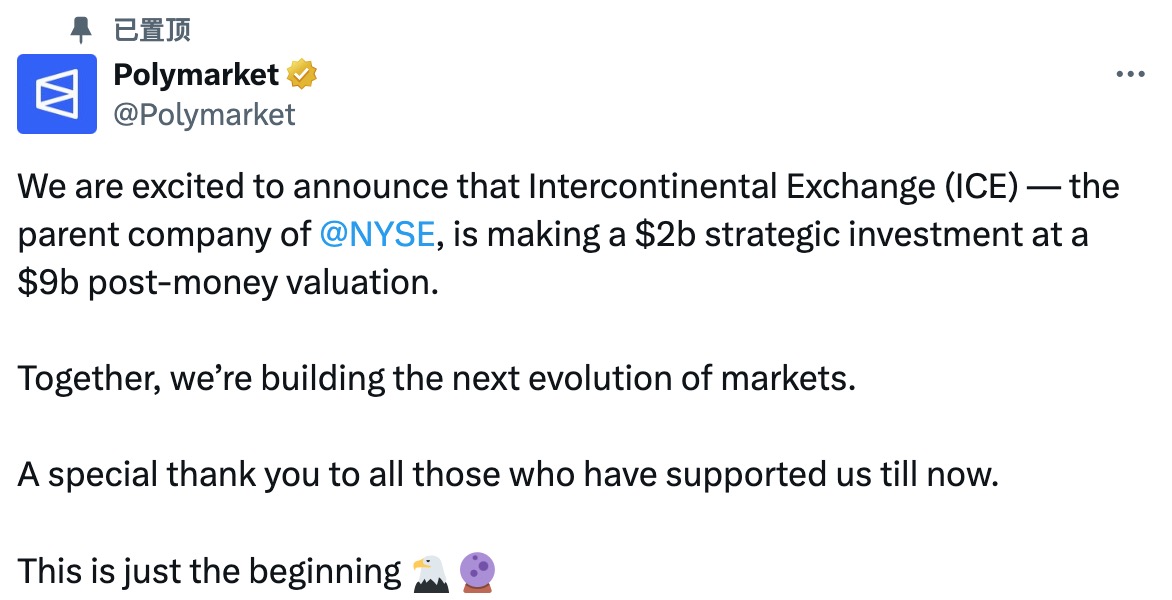Written by: Yangz, Techub News
As evidenced by CZ's tweet during the National Day and Mid-Autumn Festival, which propelled the explosion of "Binance Life" and other BNB Chain meme coins, in an era of information explosion, a single tweet can drive price fluctuations faster than a quarterly financial report, and a single internet meme can trigger a tsunami in the capital markets. The pulse of the market is being driven in unprecedented ways by the collective emotions, narratives, and beliefs of global netizens.
Last night, this profound transformation reached a milestone: the decentralized prediction market platform Polymarket announced a strategic investment of up to $2 billion from the Intercontinental Exchange (ICE), the parent company of the New York Stock Exchange (NYSE), with a post-investment valuation of $9 billion. This is not only one of the most eye-catching investments in the crypto space in recent years, but it also serves as a resounding declaration: the very form of financial markets is undergoing a fundamental evolution.

The Turn of Giants
ICE, the financial infrastructure giant that controls the world's largest securities exchange and carries nearly 29 trillion dollars in listed market capitalization, has always been seen as a barometer of industry trends. This substantial bet on Polymarket is far from a simple financial investment; it is a strategic positioning for the future. It clearly indicates that traditional financial giants like ICE have recognized that the boundaries of the market are "expanding" from mere assets (such as stocks and bonds) to broader fields. This expansion is not merely a linear growth in trading volume and scale, but a qualitative change in the market participants and pricing targets.
The new generation of investors is no longer confined to trading floors; they "live" online. In the modern economy, attention, topics, and collective beliefs have become an indispensable part of the price discovery process. This means that "ordinary people," through their attention, discussions, and the data trails of their beliefs, have reached an unprecedented level of influence over the market, and the prediction market represented by Polymarket is the perfect tool to transform this "attention" itself into tradable assets.
Of course, ICE's ambitions may go far beyond merely investing in a rapidly growing prediction market. What it is eyeing may also include entirely new, revolutionary datasets.
In traditional financial data streams, we can see "after-the-fact" or "current" information such as prices, trading volumes, and interest rates. However, Polymarket's market can generate real-time probabilities regarding elections, policy decisions, macroeconomic data releases, and even entertainment events that influence public sentiment. These "probabilities" about future events capture and quantify the collective beliefs and expectations of the market long before the event outcomes are reflected in company balance sheets.
According to this transaction, ICE plans to act as a "data distributor," integrating these real-time probability data streams into its global distribution network, delivering them to institutional clients worldwide through the same financial "pipeline" as existing stock and derivative data. This will undoubtedly impact the form of market intelligence, building an institutional-level bridge between attention and price. In the future, stock analysts may overlay event probabilities with earnings forecasts, while quantitative departments may conduct stress tests on investment portfolios in response to shifts in market beliefs.
What ICE wants is a dataset that describes "what has already happened" and predicts "what might happen next."
Why Polymarket?
So, why did ICE choose Polymarket over another prediction market giant, Kalshi?
First, technically, Polymarket's "decentralized" nature provides unique advantages that centralized platforms like Kalshi do not possess. The subjects handled by prediction markets involve sensitive information about the truths of the real world. In major issues such as elections and policies, the potential risks of intervention on centralized platforms are burdens that institutional capital and a broad user base cannot bear. When information (or misinformation) can move capital, who can guarantee the absolute honesty of the process?
Secondly, technical ideals alone are not enough to support a $9 billion valuation. ICE's significant investment is also a recognition of Polymarket's recent key breakthroughs in compliance and strategy.
Polymarket not only secured $200 million in funding led by Founders Fund, founded by Peter Thiel, in June, but also received tens of millions of dollars in investment from a venture capital fund backed by Donald Trump Jr. in August, inviting him to join the company's advisory board.
In early September, Polymarket announced it had received approval from the Commodity Futures Trading Commission (CFTC) to "return to the U.S." This compliance breakthrough not only lifted its operational shackles in the U.S., the world's largest financial market, but also sent a strong signal to the entire market: Polymarket is being incorporated into the mainstream financial regulatory landscape in a compliant manner, clearing the most fundamental legal obstacles for ICE to distribute its data streams to U.S. institutional clients.
It is worth noting that ICE itself has connections to the Trump camp—its CEO Jeffrey Sprecher's wife, Kelly Loeffler, is a close ally of Trump and currently serves as the head of the U.S. Small Business Administration. Donald Trump Jr.'s investment not only brings brand influence to Polymarket on a public level but also hints at a potentially deeper network connection among the three, laying the groundwork for future policy communication and business expansion.
Conclusion
From CZ's tweet triggering the Chinese meme coin craze to ICE's massive investment in the prediction market, we are witnessing a deep migration of financial paradigms. The pricing power of the market no longer solely relies on financial reports and economic models but is increasingly intertwined with the collective narratives, real-time emotions, and belief fluctuations of global netizens.
ICE's investment is not just a business decision; it is a vote for the future of finance. When this traditional financial giant decides to incorporate "social consensus" and "event probabilities" into its data distribution network, it signifies that capital flows will synchronize with belief flows, and price discovery will merge with probability forecasting.
免责声明:本文章仅代表作者个人观点,不代表本平台的立场和观点。本文章仅供信息分享,不构成对任何人的任何投资建议。用户与作者之间的任何争议,与本平台无关。如网页中刊载的文章或图片涉及侵权,请提供相关的权利证明和身份证明发送邮件到support@aicoin.com,本平台相关工作人员将会进行核查。


